
GBP/USD Price Forecast - Pound Holds Near 1.3130 as BoE Cut Odds Rise and Fed Hawkish Tone Lifts the Dollar
The Pound Sterling remains weak ahead of the Bank of England’s policy meeting, with traders pricing a 33% chance of a cut to 3.75% | That's TradingNEWS
GBP/USD (Pound Sterling vs US Dollar) Stuck Near 1.3130 as BoE Decision Looms and Fed Hawkish Tone Lifts Dollar
The British Pound (GBP/USD) remains under intense pressure, trading near 1.3130, only marginally above last week’s six-month low at 1.3100. The pair continues to struggle as the U.S. Dollar Index (DXY) holds firm near a three-month high, underpinned by fading expectations of another Federal Reserve rate cut in December. The U.K. fiscal outlook and uncertainty ahead of Thursday’s Bank of England (BoE) policy meeting further weigh on sentiment. Traders remain cautious, balancing the risk of a potential BoE rate reduction against the resilience of the dollar, which continues to benefit from robust U.S. data and safe-haven inflows.
Fed Stance and U.S. Data Reinforce Dollar Strength
Federal Reserve Chair Jerome Powell’s recent remarks dismissing the need for near-term easing have helped solidify the dollar’s rebound. Despite slowing ISM manufacturing data, which printed at 48.7 for October versus 49.1 previously, investors remain confident the Fed will hold rates steady until at least March 2026. Supporting the Greenback’s strength are rising U.S. Treasury yields, with the 10-year note trading around 4.31%, and a government shutdown now entering day 33, fueling uncertainty but also reinforcing the perception of U.S. fiscal resilience. The Consumer Price Index (CPI) rose 0.3% in September, pushing the annual inflation rate to 3%, below the 3.1% forecast but still well above the Fed’s 2% target. This combination of sticky inflation and resilient growth has discouraged bets on further rate cuts, limiting any sustainable Pound recovery.
BoE Policy and U.K. Fiscal Headwinds Limit Sterling Recovery
In the United Kingdom, expectations for a 25-basis-point BoE rate cut have risen sharply, with money markets pricing roughly a 33% probability of a reduction to 3.75%. The move comes amid persistently weak productivity, mounting fiscal strain, and subdued consumer confidence. The Office for Budget Responsibility (OBR) is expected to trim its productivity forecast by 0.3%, potentially worsening the national budget deficit by over £20 billion by 2030. Current finances already show a £22 billion shortfall, amplifying pressure on Chancellor Rachel Reeves to raise taxes or expand borrowing in the November budget. This fiscal backdrop continues to act as a ceiling for any Pound gains, particularly as investors anticipate tighter liquidity conditions ahead of year-end.
Technical Picture: 1.3100 Support and 1.3170 Resistance Define Near-Term Battle Zone
From a technical standpoint, GBP/USD is consolidating between 1.3110 and 1.3170, with repeated failures to break above the 1.3170 resistance keeping momentum bearish. A slide below 1.3100 could expose the 1.3000 handle, last seen in April, while a rebound above 1.3170 would open the door to 1.3225, where the 50-day moving average currently sits. The Relative Strength Index (RSI) remains neutral around 45, indicating space for either direction but no strong reversal signal yet. According to UOB, the current rebound from oversold levels signals near-term consolidation rather than a trend reversal. The pair remains vulnerable as long as it trades below 1.3250, the key pivot separating correction from recovery.
Diverging Inflation Paths Between the U.S. and U.K.
The policy divergence between Washington and London continues to dictate currency flows. The latest data show U.K. inflation at 3.5%, still well above the BoE’s 2% target, forcing the central bank into a defensive stance despite slowing growth. Conversely, U.S. inflation at 2.8% is closer to normalization, allowing the Fed to maintain a hawkish hold without triggering market panic. This gap widens the yield differential in favor of the dollar, making Sterling less attractive for carry trades. The BoE’s base rate at 5.0% currently offers a narrow premium over U.S. policy rates, but that advantage may erode if the Fed stays higher for longer while U.K. inflation decelerates.
Market Sentiment: Derivative Traders Eye Cheap Options for Reversal Plays
Options traders have begun repositioning as volatility falls. Implied volatility on GBP/USD options has dropped to its lowest level in three months, presenting an opportunity for low-cost strategies anticipating a rebound. Analysts at VT Markets note that call spreads expiring in Q1 2026 are attracting interest, as traders position for a potential slow recovery toward 1.3400 should the Fed turn dovish. For now, however, the market remains short-biased. Speculative positioning data show hedge funds maintaining a net-short exposure of roughly 22,000 contracts, reflecting skepticism over the Pound’s near-term resilience.
Macroeconomic Risks and Investor Focus Ahead of BoE
The coming week centers on Thursday’s BoE meeting, where the committee is expected to vote narrowly—potentially 5-4—to hold rates steady. Goldman Sachs forecasts a 25-basis-point cut, while ING expects no change but warns that the December meeting could bring easing if fiscal risks intensify. Meanwhile, S&P Global’s PMI manufacturing index was revised slightly higher to 49.7, marking the first expansion in a year but still signaling fragile growth. Director Rob Dobson of S&P Global Market Intelligence cautioned that “the rebound could prove short-lived” given weak export demand and ongoing fiscal tightening. These mixed indicators keep traders cautious, with most expecting sideways movement until policy clarity emerges.
Read More
-
SCHD ETF Price at $27: Can SCHD’s 4% Yield and 9.15% Dividend Growth Beat High-Yield Covered Call ETFs?
15.12.2025 · TradingNEWS ArchiveStocks
-
XRP ETFs Close on $1B Inflows as XRPI at $10.92 and XRPR at $15.52 Hit 52-Week Lows
15.12.2025 · TradingNEWS ArchiveCrypto
-
Natural Gas Price Forecast: NG=F Holds the $4 Floor as Oversupply Clashes with 2026 LNG Demand
15.12.2025 · TradingNEWS ArchiveCommodities
-
USD/JPY Price Forecast - Dollar to Yen At 155: Yen Strength Builds As BoJ Hike And NFP Collide
15.12.2025 · TradingNEWS ArchiveForex
Global Trade, U.S.–China Talks, and Pound Correlation
Earlier optimism surrounding a U.S.–China trade thaw briefly lifted sentiment, but structural concerns persist. Although agreements on export controls and shipping levies reduced supply bottlenecks, the global manufacturing rebound remains uneven. For the Pound, this matters: softer Chinese and European demand directly affect U.K. export growth, particularly in the automotive and energy sectors. Meanwhile, a prolonged U.S. government shutdown has introduced fiscal uncertainty but paradoxically strengthened the dollar as global investors seek liquidity.
Forecast: GBP/USD to Trade Between 1.3000–1.3250 Into Q1 2026
The overall market view for GBP/USD remains cautious. With U.S. yields elevated and the BoE expected to hold rates or cut marginally, upside remains capped. Analysts see the pair fluctuating within a 1.3000–1.3250 range through early 2026, barring a sharp shift in Fed rhetoric or a surprise BoE intervention. Short-term sentiment favors the dollar, but the long-term interest rate differential and cheaper valuation for Sterling could attract buyers once global risk appetite stabilizes.
Verdict: HOLD – Neutral-to-bearish near term with downside risk toward 1.3000; potential rebound toward 1.3400 in early 2026 if BoE stabilizes inflation and Fed begins easing.



















